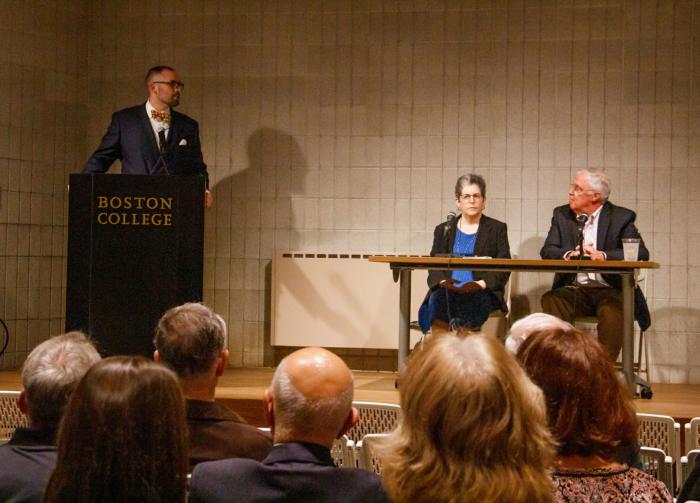Local
New BC exhibit looks at Cardinal Cushing's legacy in interfaith relations
By Jacqueline Tetrault Pilot Staff
Posted: 11/1/2019


Archdiocesan archivist Thomas Lester moderates the panel discussion with professors Ruth Langer and James O'Toole at the exhibit's opening reception Oct. 23. Pilot photo/Jacqueline Tetrault
BRIGHTON -- A new exhibit at the Boston College Theology and Ministry Library looks at the development of Catholic interfaith relations around the Second Vatican Council and Cardinal Richard Cushing's important role in that process.
The exhibit, entitled "We Are All Children of God: Interfaith Relations in 20th Century Boston," is a collaboration of the Archives of Archdiocese of Boston and the Theology and Ministry Library. It features displays of items related to Cardinal Richard Cushing or the Second Vatican Council as well as a selection of library books about interfaith relations. Display panels provide information about Cardinal Cushing, the council, and the Church's efforts to promote ecumenical and interfaith dialogue.
A reception and speaking program took place at the Theology and Ministry Library on Oct. 23 to mark the launch of a new exhibit.
Father Stephen Salocks, interim rector of St. John Seminary, offered welcoming remarks and spoke about his experience teaching Scripture over the past 30 years. He said he has always emphasized that anyone learning how to preach the gospel must be familiar with the Old Testament.
Father Salocks recalled how St. John Seminary was "caught up in the ecumenical spirit" of the decades following Vatican II.
Multiple speakers made reference to the Vatican II document, "Nostra Aetate," the Declaration on the Relation of the Church to Non-Christian Religions. One of four documents on interfaith relations produced by the Council, "Nostra Aetate" identified the commonalities between Christianity, Judaism and Islam, and repudiated the centuries-old accusation that the Jewish people were culpable for the death of Christ.
"One of the principles that guided our study of 'Nostra Aetate' is that the Catholic Church rejects nothing that is true and holy in non-Christian religions," Father Salocks said.
MaryJo Donzella, an archivist of the archdiocese, shared remarks about the exhibit and Cardinal Cushing's legacy. She described Cardinal Cushing as having a "unique ability to see commonalities rather than differences."
"This simple notion remains just as relevant today as it was during his era, and we at the Archdiocese of Boston are proud to be able to share a small piece of this history with you, in the hope that it inspires you to investigate further, not only to learn the events of the past, but (also) how embracing such an outlook can effect a positive change for the future," Donzella said.
The keynote speaker was Father Jim Bernauer, SJ, Kraft Family professor of philosophy and director of the Center for Christian-Jewish learning at Boston College. Father Bernauer noted that Cardinal Cushing's two speeches at the Second Vatican Council played a "decisive role" in changing Church teaching on Judaism.
He recalled a conversation he once had with a Jewish man whose brother had attended Boston College decades earlier. During the graduation ceremony, each graduate received their diploma from Cardinal Cushing and was then expected to kneel and kiss his ring. But when Cardinal Cushing heard the student's Jewish name, he instead extended his hand for a handshake. That gesture meant a lot to the student's family, Father Bernauer said.
After the speaking program, Thomas Lester, archivist and records manager of the archdiocese, moderated a panel discussion featuring two Boston College faculty members: Dr. Ruth Langer, professor of Jewish studies and associate director of the Center for Christian-Jewish Learning, and Dr. James O'Toole, a professor of history and former diocesan archivist.
The professors responded to Lester's questions about 20th century trends and shifts in interfaith dialogue.
"It's hard, I think, for people in the 21st century, such as ourselves, to realize how high the barriers between religious faiths were in the past," O'Toole said, explaining that these barriers were manifested in both "formal" and "informal" ways. For instance, pastors seeking their bishops' permission to participate in public events with leaders of other faith communities would be discouraged from going.
Langer and O'Toole discussed ways in which relationships between Jews and Catholics were changing on the local level even before Vatican II. They noted that people of different religions served together in World War II, and in the postwar years many families moved from urban neighborhoods into suburbs.
"I think that laid the foundation in the period immediately after the war. As I say, it's happening on the ground, it's not at any kind of intellectual, theological level. But it's making new ways of thinking on those levels possible in a way that they haven't been before," O'Toole said.
Langer noted that "Nostra Aetate" had some "holes" that were addressed by later documents, but that those documents do not carry the same authority. She said the process "Nostra Aetate" initiated "has grown and developed and created new possibilities."
"'Nostra Aetate' is necessary but not sufficient, in a way," she said.
The panel discussion was followed by a question-and-answer period with the audience.
A graduate student named Theresa who attended the event said she liked Father Bernauer's candid analysis of both negative and positive changes in the Jesuits' attitudes toward Judaism throughout their order's history. Although St. Ignatius of Loyola, founder of the Society of Jesus, resisted political and ecclesiastical pressure to exclude Jewish converts to Catholicism, after his death the Jesuits banned all people of Jewish or Saracen descent from their order. This ban was not lifted until 1946.
"I really enjoyed his talk because he was very honest about the dynamics of Jewish and Catholic relationship," Theresa said, speaking to the Pilot after the panel discussion.
The exhibit will be in the Boston College Theology and Ministry Library for the remainder of the semester.